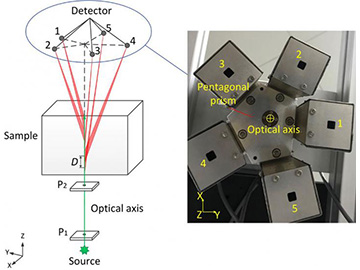Security Technology Gets a Boost – Optics & Photonics News

Diagram and photo of spiral EDXRD system, a setup that, according to scientists at Tongji University and Zhejiang University City College, China, could improve the efficiency and imaging depth of airport security systems. [Image: Baozhong Mu]
Airport X-ray systems detect suspicious items in about 5% of the luggage they examine. When they do, security personnel must inspect the contents by hand. Researchers have suggested that a sophisticated imaging technology called energy-dispersive X-ray diffraction (EDXRD) could replace those time-consuming inspections. But current EDXRD, as it’s known, has a serious limitation: It can detect objects only in small, thin areas.
Now, researchers at two Chinese universities have developed and tested an EDXRD system that, they say, overcomes that limitation (AIP Adv., doi: 10.1063/1.5126051).
Spectroscopic fingerprint
Conventional X-ray detection systems fail to differentiate suspicious objects, says Baozhong Mu of Shanghai’s Tongji University, “because the effective atomic numbers and densities of explosives, drugs, and key raw materials are similar to those of usual organic matter.” EDXRD technology overcomes that problem by using X-rays of various wavelengths and a detector with specific geometry.
The result, Mu and colleagues from Zhejiang University City College in Hangzhou write in the new study: “In an EDXRD spectrum, the combination of all the peak positions and intensities provides a unique spectroscopic ‘fingerprint,’ from which the material can be identified.”
Spiral array
The technology itself isn’t new. Teams at University College, London and GE Security are developing their own versions of EDXRD, called DILAX and XDI. But these are extremely expensive or limited to examining luggage much thinner than typical suitcases.
Mu’s team has increased the technology’s detection capacity by placing five relatively cheap detectors in a spiral array. The approach successfully identified illicit pills mixed with legal powders and covered by clothes in a 4-inch thick bag, the team reports.
That’s just a start. “Our next job is improving the detection speed, through development of detectors and beam utilization.” Mu says. And after that? “The system will be commercialized in the future, based on market needs and technology maturity,” he adds. The ultimate goal is to enable airport security to use conventional X-ray imaging for preliminary screening and EDXRD to make accurate judgments about suspicious items without needing to open and inspect luggage by hand.






